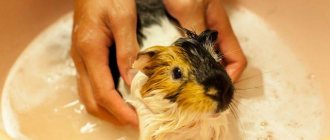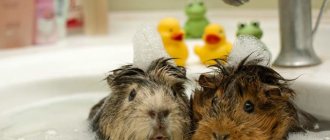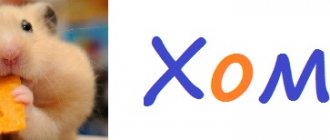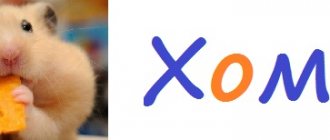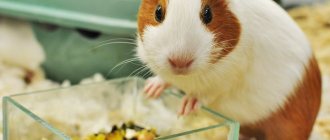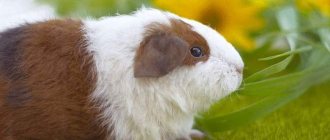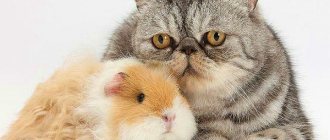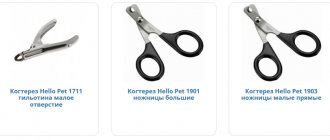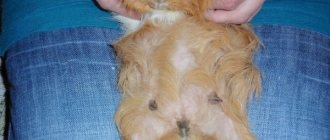We learn how to cut a guinea pig's hair and trim its claws. What you need to know about caring for your pet's long hair. When it is necessary to cut the wool. How to properly cut a haircut and what tool to use. Do you need to trim your guinea pig's claws and how to do it correctly.
Guinea pigs need the care and attention of their owners, which is manifested not only in arranging the territory for housing and food, but also in bathing, caring for fur and claws, cleaning ears and other actions.
Some breeds have quite long fur that they cannot handle on their own, so owners must help the pet care for it. Next, we will look in detail at how to properly care for the fur, whether it is possible to trim your pet, and how to carry out the procedure correctly.
Preventive examination of guinea pigs
Every 3-4 days you need to watch the pig a little and carefully examine it. A healthy animal is active, eats willingly, its fur is shiny, without bald spots. It is also important to check whether there are any wounds on the skin, diarrhea, runny nose, wheezing when breathing, and whether the eyes are purulent. Regular inspection of your pigs will allow you to take timely action if necessary.
The pig should be given the opportunity to move a little. You definitely need to let her out for a walk around the apartment every day. At the same time, it is worth vigilantly watching this small animal so as not to accidentally step on it or get pinched by doors. A pig that no one pays attention to may test its teeth on the furniture. Naturally, if you have other animals that may be unsafe for the rodent, they should be locked in another room while the pig is walking.
If you want to pick up a pig, then you should catch and pick it up with a quick and decisive movement. We clasp the back and chest with one hand, and place the other under the butt. Newborn pigs and pregnant females should not be carried in your arms.
Feeding recommendations
The pet needs to be fed correctly so that its health remains normal, its teeth are strong, and its coat looks well-groomed. Your pet's daily menu should include:
- 50% hay;
- 20% dry food;
- 20% juicy food;
- 10% greens.
An important question for owners is how many times a day to give food to a guinea pig. Feeding is carried out 3 times a day. The feeder cannot be removed from the cage; food must always be available to the animal. There should also always be hay in the cage.
If there is no dry food in the animal’s diet, then it must be replaced with a similar weight of greens and raw vegetables. The menu should be varied; the rodent must be offered at least three different vegetables per day and certainly grass. It is prohibited to give your pet grass collected on the sides of highways and in industrial areas.
The optimal menu is vegetables and fruits before noon, dry food after noon.
Guinea pig brushing
Short-haired and rosette pigs take care of their personal toilet on their own. Using their claws and teeth, they clean and comb their fur coat. However, it will not harm the animal if from time to time we comb it with a brush and wipe it with a dry cloth. Frequent brushing is necessary for long-haired pigs. This is necessary not only to prevent it from falling into tangles, but also to massage the skin. If the fur in some area is tangled into a lump, then it is simply carefully cut off with scissors.
To comb the fur, you should use special combs and brushes. The Angora pig can be trimmed before the onset of summer. For long-haired beauties who have become mothers, it is also recommended to shorten the hair around the nipples to make it easier for babies to find milk.
The most demanding breed, of course, is the Angora breed, that is, the Peruvian pig, due to its coat, which reaches 20 cm in length. Such an animal must be brushed (with a soft brush) at least once a week - preferably two or three times a week - to prevent tangling of the fur. Brushing your hair with a brush provides a silky shine, but only in combination with an appropriate diet. If you feed your pig inappropriately, its coat will remain dull no matter how much you groom it.
A very beneficial effect on the coat will be provided if you give it sunflower seeds and flaxseed, taking into account certain ingredients contained in these seeds.
Normal-furred and rosette guinea pigs should only be brushed twice a week when they shed, usually in the spring and fall. Long-haired guinea pigs require daily brushing and combing. Get your guinea pig used to this procedure from a very early age. Take the animal on your lap, laying down a towel first. Detangle your hair with a long-toothed comb. Animal fur can be slightly moistened with water from a spray bottle - the comb will be less likely to touch and tug at the hair.
Brush the fur with a soft brush until shiny. Trim matted or matted areas, especially in the back of the body, with scissors or wash with a special anti-hairball shampoo for cats (available at pet stores). Then dry the fur with a hairdryer.
Preparation for the procedure
Before starting the procedure, you need to prepare your tools. For cutting you will need special tweezers. They are sold in pet stores and are called rodent nail clippers. A nail clipper for rodents can be replaced with children's tweezers or a nail clipper for cats. For very small piglets, regular nail scissors are also suitable, since babies have soft nails. In cases where it is impossible to accurately determine the safe place to use a nail clipper, it is better to use a nail file. An ordinary nail file that people use or a special device - an electric sharpener - will do. It is sold in pet stores. The nail plate of animals contains a nerve ending and a vessel. If you cut a nail and touch a vessel or nerve, bleeding will occur. In this case, you will need powder to stop bleeding. This may be a special product that is sold in a pharmacy. Chlorhexidine, hydrogen peroxide, brilliant green and a weak solution of potassium permanganate are also suitable for treating the wound. In case of treatment with liquid products, you will need cotton pads. You will also need a towel for a manicure. The pet is wrapped in it to calm it and prevent bites.
Guinea pigs bathing
You should only bathe your guinea pig if absolutely necessary. For example, if, due to diarrhea, the fur around the anus becomes contaminated with feces, or if the animal is very dirty with soil and the only way out is bathing.
If you are forced to bathe your pig, you need to act as follows.
Fill a plastic bowl with water at room temperature to a height of 2.5-3 cm from the bottom of the bowl. Place the animal in the water, soaking it only as long as necessary. Wash him gently, making sure to keep his head above the surface of the water at all times. If necessary, you can use a delicate baby shampoo without, however, touching the animal’s head; the shampoo should then be thoroughly rinsed off. Once bathing is complete, remove your pig from the water and dry him gently with a towel.
If the room temperature is above 18°C, it is enough to dry the animal, but if the room is cooler, you need to dry it with a hair dryer. A long-haired pig should always be dried with a hairdryer, but only set to the lowest temperature. A completely dry animal is placed in a clean and dry cage lined with hay. It must be remembered that a bathed guinea pig is especially sensitive to drafts and cold, and is susceptible to colds, the consequences of which can be detrimental.
Veterinarian at home 24/7
Tama the Cat: Train Station Master
This happened in the early 2000s, when the unprofitable Kishi station in the Japanese city of Kinokawa was almost closed due to unprofitability. Residents, of course, protested, but it is unlikely that their efforts would ultimately be crowned with success. The situation was saved by a local cat named Tama, who loved to bask in the sun near the train station. The station manager noticed how enthusiastically passengers reacted to this couch potato and gave him the official position of caretaker. The cat was given a uniform cap, a badge and a monthly salary in the form of free food.
The duties of the newly minted minister included advertising functions. He greeted passengers, allowed himself to be petted, and was always somewhere on the platform. It must be said that this policy very quickly led to commercial success. Tourists began to come to Kishi station just to look at the railway cat and take pictures with him. From that moment on, there was no further talk about closing the station.
But the unusual cat's career did not end there. In 2008, Tama became a supervisor and was charged with monitoring the performance of professional duties by staff. That same year, the cat was knighted. Another year later, according to the project of the famous designer Eiji Mituku, the railway included in the schedule a train dedicated to the legendary animal. The carriages were painted with views of Tama, the locomotive was decorated with his muzzle, and meowing signaled the opening (closing) of the doors. But this did not become the crown of the cat’s career.
A year later, Tamu was appointed third party of the railway company, entrusted with the post of executive director. By his old age, it was already difficult for him to work every day, and the management allowed the elderly cat to come to work 3 days a week.
Tama died at the ripe old age of 14. But even after this, the career did not end. Posthumously, the cat was elevated to the rank of Eternal Station Master, thus perpetuating his memory. After all, over the years of work, this four-legged employee has brought considerable income to his company. The tourist flow through the station increased to 300 thousand people annually, and the financial indicator amounted to more than 1.1 billion Japanese yen.
The company's management did not want to accept the loss of such a profitable and already promoted advertising brand. Tama was replaced by Nitama (the second Tama). True, later with the third cat there was an overlay. He was found at Okayama Station and offered a position in Kishi. But the owner did not agree to the move. Next came Yontama (the fourth Tama), who had already had to undergo a special training course before taking her place on the platform of the railway station.
And the flow of tourists wanting to take a photo with the legendary heirs of the first Tama still does not dry out.
I like2I don't like
Guinea pig dental care
Lack of adequate solid food can lead to excessive tooth growth. Guinea pigs, like all rodents, continually grow their front teeth (incisors), even if they use them intensively. This poses a considerable danger, since teeth that are too long make it difficult to eat, and their sharp ends can puncture the tongue or gums. As a result, the animal stops eating altogether and the intervention of a veterinarian is required. In addition to solid food, it is recommended to let your pig chew on various (safe for her) objects.
Unfortunately, such a defect as congenital malposition of teeth is quite common. In such cases, they need to be trimmed by a veterinarian every two to three months.
How often to do this
For the first time, guinea pigs' claws are trimmed between 1 and 3 months, when the claws have already begun to bend and grow to the sides. In the future, the need for another procedure is determined by the rate of bone tissue growth; on average, it is performed once every 2–4 weeks, as soon as the length of the claws exceeds 2 mm.
Important! After using the hemostatic powder, its remnants must be removed so that the chemical does not get into the pet’s mouth. The most minor consequences of this will be indigestion and vomiting.
Trimming guinea pigs' claws
In addition to taking good care of your teeth, an important element of caring for your guinea pig is keeping its claws in good condition. The point is to ensure that they do not grow too long, as this would make it difficult for the animal to move.
In bred guinea pigs, the claws do not wear off on their own sufficiently, so the owner is obliged to help them with this. However, this should be done very carefully and only when absolutely necessary. In this case, another person is needed to care for the animal. The most suitable tool is sharp special scissors or nail trimmers. Excessively long claws are shortened with special scissors or claw tongs, taking care not to damage living tissue.
A slight excess of the length of the incisors is eliminated using a nail file, and very long teeth are trimmed with sharp special scissors. However, if you have never performed this type of operation before, have it done by an experienced person.
You cannot cut the claws too short, because the upper parts contain nerves and blood vessels. Damage to this living tissue causes excruciating pain to the animal, the wound takes a long time to heal, and chronic infection can occur as a complication. In a situation where living tissue is damaged, it is necessary, first of all, to stop the bleeding using a constrictor (for example, lapis bacillus), and then take care of cell hygiene as much as possible in order to prevent infection.
The claws must be trimmed carefully. It is better to do this in front of a bright light, so as not to make a mistake and damage the blood vessels. It is easy to recognize the place to which a claw can be trimmed in light-colored animals. Examining the claw in the light, you will see translucent blood vessels; Circumcision is allowed only within the transparent area. To do this, you need special scissors or nail trimmers. During this procedure, you need to hold the pig carefully, but firmly - it will try to tear its paw out of your fingers. And one more thing - try to ensure that the cutting edge is located across the claw. It may crack if cut at an angle.
If the claws are dark, it is very difficult to determine the location of the blood vessels. In this case, this procedure should be carried out by two people: one holds the guinea pig and illuminates the claws from below with a spotlight, the other trims them. Rodents' nails are trimmed at approximately 1 year of age, and then 1-2 times a year. In nature, they wear down naturally on sand and stones, but at home they grow excessively, which brings discomfort and pain to pigs. To prevent the claws from crumbling, you should use special tweezers (can be purchased at a pet store).
Preparing tools
The most sensitive part of a guinea pig is its claws. The claw contains pulp with blood. If you trim the nail incorrectly, your pet will bleed, which will lead to serious consequences, including numbness of the limb. How to trim a guinea pig's claws without harming the pet? Thorough preparation is the first step to a successful procedure. Before cutting an animal, you need to purchase the appropriate tools:
- Wire cutters. You can cut it for children or buy a tool in the store.
- Powder to stop bleeding. Beginners who have recently acquired a rodent, when cutting, touch a blood vessel or deform their nails. The powder allows you to quickly stop bleeding. Corn starch is commonly used.
- Terry towel. An animal wrapped in soft fabric will stop being nervous.
Origin story
Many people are interested in the question: why is the pig called “guinea pig”? Paradoxically, the animal is in no way related to ordinary pigs and has never lived in the sea. There is a theory that the pig was originally called “overseas”, but gradually the name changed a little. It first came to Europe from North Africa, although South America is considered the homeland of this wonderful animal. The indigenous people of the American continent not only ate guinea pigs, but also sacrificed them to the gods. The Indians destroyed black individuals, as they considered them a harbinger of trouble. Today, the black guinea pig is considered the most fashionable and expensive species.
